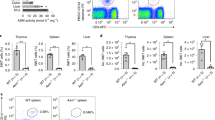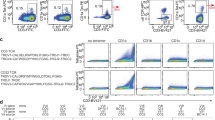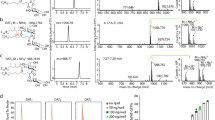Abstract
Members of the CD1 family present antigenic lipids to T lymphocytes. CD1 molecules survey endocytic compartments for lipid antigens that are sorted into these vesicles after incorporation into the membrane bilayer, and extraction from the bilayer is likely to be a critical step for lipid association. We hypothesized that lysosomal saposins, which are cofactors required for sphingolipid degradation, might be involved in this process. Here we show that saposins, although not required for the autoreactive recognition of CD1d by natural killer T cells, are indispensable for the binding of an exogenous lipid antigen, α-galactosylceramide, to CD1d in the endocytic pathway. We suggest that saposins mobilize monomeric lipids from lysosomal membranes and facilitate their association with CD1d.
This is a preview of subscription content, access via your institution
Access options
Subscribe to this journal
Receive 12 print issues and online access
$209.00 per year
only $17.42 per issue
Buy this article
- Purchase on Springer Link
- Instant access to full article PDF
Prices may be subject to local taxes which are calculated during checkout






Similar content being viewed by others
References
Porcelli, S.A. & Modlin, R.L. The CD1 system: antigen-presenting molecules for T cell recognition of lipids and glycolipids. Annu. Rev. Immunol. 17, 297–329 (1999).
Beckman, E.M. et al. Recognition of a lipid antigen by CD1-restricted αβ+ T cells. Nature 372, 691–694 (1994).
Moody, D.B. et al. CD1c-mediated T-cell recognition of isoprenoid glycolipids in Mycobacterium tuberculosis infection. Nature 404, 884–888 (2000).
Porcelli, S., Morita, C.T. & Brenner, M.B. CD1b restricts the response of human CD4-8-T lymphocytes to a microbial antigen. Nature 360, 593–597 (1992).
Sieling, P.A. et al. CD1-restricted T cell recognition of microbial lipoglycan antigens. Science 269, 227–230 (1995).
Shamshiev, A. et al. Self glycolipids as T-cell autoantigens. Eur. J. Immunol. 29, 1667–1675 (1999).
Shamshiev, A. et al. The αβ T cell response to self-glycolipids shows a novel mechanism of CD1b loading and a requirement for complex oligosaccharides. Immunity 13, 255–264 (2000).
Shamshiev, A. et al. Presentation of the same glycolipid by different CD1 molecules. J. Exp. Med. 195, 1013–1021 (2002).
Brossay, L. et al. Structural requirements for galactosylceramide recognition by CD1-restricted NK T cells. J. Immunol. 161, 5124–5128 (1998).
Brossay, L. et al. CD1d-mediated recognition of an alpha-galactosylceramide by natural killer T cells is highly conserved through mammalian evolution. J. Exp. Med. 188, 1521–1528 (1998).
Burdin, N. et al. Selective ability of mouse CD1 to present glycolipids: α-galactosylceramide specifically stimulates Vα14+ NK T lymphocytes. J. Immunol. 161, 3271–3281 (1998).
Gumperz, J.E. et al. Murine CD1d-restricted T cell recognition of cellular lipids. Immunity 12, 211–221 (2000).
Kawano, T. et al. CD1d-restricted and TCR-mediated activation of Vα14 NKT cells by glycosylceramides. Science 278, 1626–1629 (1997).
Spada, F.M., Koezuka, Y. & Porcelli, S.A. CD1d-restricted recognition of synthetic glycolipid antigens by human natural killer T cells. J. Exp. Med. 188, 1529–1534 (1998).
Zajonc, D.M., Elsliger, M.A., Teyton, L. & Wilson, I.A. Crystal structure of CD1a in complex with a sulfatide self antigen at a resolution of 2.15 Å. Nat. Immunol. 4, 808–815 (2003).
Gadola, S.D. et al. Structure of human CD1b with bound ligands at 2.3 Å, a maze for alkyl chains. Nat. Immunol. 3, 721–726 (2002).
Moody, D.B. & Porcelli, S.A. Intracellular pathways of CD1 antigen presentation. Nat. Rev. Immunol. 3, 11–22 (2003).
Briken, V., Jackman, R.M., Watts, G.F., Rogers, R.A. & Porcelli, S.A. Human CD1b and CD1c isoforms survey different intracellular compartments for the presentation of microbial lipid antigens. J. Exp. Med. 192, 281–288 (2000).
Jackman, R.M. et al. The tyrosine-containing cytoplasmic tail of CD1b is essential for its efficient presentation of bacterial lipid antigens. Immunity 8, 341–351 (1998).
Sugita, M. et al. Cytoplasmic tail-dependent localization of CD1b antigen-presenting molecules to MIICs. Science 273, 349–352 (1996).
Sugita, M., van Der Wel, N., Rogers, R.A., Peters, P.J. & Brenner, M.B. CD1c molecules broadly survey the endocytic system. Proc. Natl. Acad. Sci. USA 97, 8445–8450 (2000).
Roberts, T.J. et al. Recycling CD1d1 molecules present endogenous antigens processed in an endocytic compartment to NKT cells. J. Immunol. 168, 5409–5414 (2002).
Sugita, M. et al. Separate pathways for antigen presentation by CD1 molecules. Immunity 11, 743–752 (1999).
Chiu, Y.H. et al. Distinct subsets of CD1d-restricted T cells recognize self-antigens loaded in different cellular compartments. J. Exp. Med. 189, 103–110 (1999).
Chiu, Y.H. et al. Multiple defects in antigen presentation and T cell development by mice expressing cytoplasmic tail-truncated CD1d. Nat. Immunol. 3, 55–60 (2002).
Brossay, L. et al. Mouse CD1-autoreactive T cells have diverse patterns of reactivity to CD1+ targets. J. Immunol. 160, 3681–3688 (1998).
Ernst, W.A. et al. Molecular interaction of CD1b with lipoglycan antigens. Immunity 8, 331–340 (1998).
Moody, D.B., Reinhold, B.B., Reinhold, V.N., Besra, G.S. & Porcelli, S.A. Uptake and processing of glycosylated mycolates for presentation to CD1b-restricted T cells. Immunol. Lett. 65, 85–91 (1999).
Moody, D.B. et al. Lipid length controls antigen entry into endosomal and nonendosomal pathways for CD1b presentation. Nat. Immunol. 3, 435–442 (2002).
Mukherjee, S., Soe, T.T. & Maxfield, F.R. Endocytic sorting of lipid analogues differing solely in the chemistry of their hydrophobic tails. J. Cell Biol. 144, 1271–1284 (1999).
Sandhoff, K., Kolter, T. & Harzar, K. Sphingolipid activator proteins. In The Metabolic and Molecular Bases of Inherited Disease (eds. Scriver, C., Beaudet, A.L., Sly, W.S. & Valle, D.) 3371–3388 (McGraw-Hill, New York, 2001).
Fujita, N. et al. Targeted disruption of the mouse sphingolipid activator protein gene: a complex phenotype, including severe leukodystrophy and wide-spread storage of multiple sphingolipids. Hum. Mol. Genet. 5, 711–725 (1996).
Exley, M., Garcia, J., Balk, S.P. & Porcelli, S. Requirements for CD1d recognition by human invariant Vα24+ CD4-CD8-T cells. J. Exp. Med. 186, 109–120 (1997).
Burkhardt, J.K. et al. Accumulation of sphingolipids in SAP-precursor (prosaposin)-deficient fibroblasts occurs as intralysosomal membrane structures and can be completely reversed by treatment with human SAP-precursor. Eur. J. Cell Biol. 73, 10–18 (1997).
Avva, R.R. & Cresswell, P. In vivo and in vitro formation and dissociation of HLA-DR complexes with invariant chain-derived peptides. Immunity 1, 763–774 (1994).
Fischer, G. & Jatzkewitz, H. The activator of cerebroside sulphatase. Binding studies with enzyme and substrate demonstrating the detergent function of the activator protein. Biochim. Biophys. Acta 481, 561–572 (1977).
Li, S.C., Sonnino, S., Tettamanti, G. & Li, Y.T. Characterization of a nonspecific activator protein for the enzymatic hydrolysis of glycolipids. J. Biol. Chem. 263, 6588–6591 (1988).
Vogel, A., Schwarzmann, G. & Sandhoff, K. Glycosphingolipid specificity of the human sulfatide activator protein. Eur. J. Biochem. 200, 591–597 (1991).
Hiraiwa, M., Soeda, S., Kishimoto, Y. & O'Brien, J.S. Binding and transport of gangliosides by prosaposin. Proc. Natl. Acad. Sci. USA 89, 11254–11258 (1992).
Morimoto, S. et al. Interaction of saposins, acidic lipids, and glucosylceramidase. J. Biol. Chem. 265, 1933–1937 (1990).
Vaccaro, A.M. et al. pH-dependent conformational properties of saposins and their interactions with phospholipid membranes. J. Biol. Chem. 270, 30576–30580 (1995).
Vaccaro, A.M. et al. Effect of saposins A and C on the enzymatic hydrolysis of liposomal glucosylceramide. J. Biol. Chem. 272, 16862–16867 (1997).
Wilkening, G., Linke, T. & Sandhoff, K. Lysosomal degradation on vesicular membrane surfaces. Enhanced glucosylceramide degradation by lysosomal anionic lipids and activators. J. Biol. Chem. 273, 30271–30278 (1998).
Ciaffoni, F. et al. Saposin D solubilizes anionic phospholipid-containing membranes. J. Biol. Chem. 276, 31583–31589 (2001).
Kobayashi, T. et al. A lipid associated with the antiphospholipid syndrome regulates endosome structure and function. Nature 392, 193–197 (1998).
Joyce, S. et al. Natural ligand of mouse CD1d1: cellular glycosylphosphatidylinositol. Science 279, 1541–1544 (1998).
De Silva, A.D. et al. Lipid protein interactions: the assembly of CD1d1 with cellular phospholipids occurs in the endoplasmic reticulum. J. Immunol. 168, 723–733 (2002).
Kang, S.J. & Cresswell, P. Calnexin, calreticulin, and ERp57 cooperate in disulfide bond formation in human CD1d heavy chain. J. Biol. Chem. 277, 44838–44844 (2002).
Kang, S.J. & Cresswell, P. Regulation of intracellular trafficking of human CD1d by association with MHC class II molecules. Embo. J. 21, 1650–1660 (2002).
Turvy, D.N. & Blum, J.S. Detection of biotinylated cell surface receptors and MHC molecules in a capture ELISA: a rapid assay to measure endocytosis. J. Immunol. Methods 212, 9–18 (1998).
Acknowledgements
We thank A. Ackerman, A. Chow, R. Lackman, D. Peaper, J-H Shim, R. Teel and W. Yuan for their help, and N. Dometios for manuscript preparation. Supported by the Howard Hughes Medical Institute.
Author information
Authors and Affiliations
Corresponding author
Ethics declarations
Competing interests
The authors declare no competing financial interests.
Rights and permissions
About this article
Cite this article
Kang, SJ., Cresswell, P. Saposins facilitate CD1d-restricted presentation of an exogenous lipid antigen to T cells. Nat Immunol 5, 175–181 (2004). https://doi.org/10.1038/ni1034
Received:
Accepted:
Published:
Issue Date:
DOI: https://doi.org/10.1038/ni1034
This article is cited by
-
CD1-mediated immune responses in mucosal tissues: molecular mechanisms underlying lipid antigen presentation system
Experimental & Molecular Medicine (2023)
-
Mrp1 is involved in lipid presentation and iNKT cell activation by Streptococcus pneumoniae
Nature Communications (2018)
-
Synthetic glycolipid activators of natural killer T cells as immunotherapeutic agents
Clinical & Translational Immunology (2016)
-
The CD1 family: serving lipid antigens to T cells since the Mesozoic era
Immunogenetics (2016)
-
Donor-unrestricted T cells in the human CD1 system
Immunogenetics (2016)



